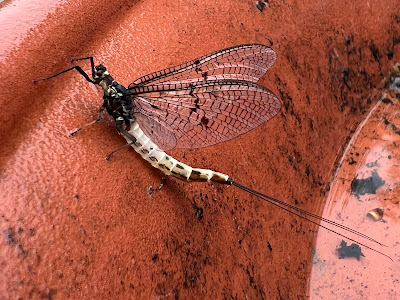On the first evening of a fortnight in the Peloponnese, Penny and I arrived quite late at our stopover hotel which brilliantly gave us supper and then provided a real entomological treat. During the meal a moth took a persistent interest in our glasses of wine which seemed a good omen, even though it was small and not particularly interesting - pic below. But on the way to our room, we stumbled on something quite else.
I was just trying to get a better picture of the moth, which had fluttered off to the stairwell, when I saw the exquisite creature shown in my first picture. Thank goodness, it was sleepy and didn't move while I took pictures. What on earth was it? The hotel staff gathered round and we had an admiring discussion. Then I went online.
The answer is as delightful as the moth. It has a variety of excellent names such as Grecian Streamertail, Greek Spoontail and Grecian Lacewing; and the last explains what it is: a magnificent relation of those delicate green lacewings which visit the trap later in the Summer and are handily used as a biological control of aphids on greenhouse plants.
Here's a familiar British insect which is one of its distant cousins, the giddily-flying Mayfly which makes such easy prey for birds as it emerges from up to two years of underwater life as a nymph. Even without the birds, few would live longer than a few hours during which they mate and the females crash-land in the water, lay their eggs and die, often as fish food although shed no tears because their inability to eat dooms them anyway within hours. The male survivors flop down somewhere on land to go the same way. How apparently sad; and yet they are one of the planet's most ancient forms of insect life, leading their curious lifestyle successfully, if that is the right word, since 100 million years before the dinosaurs.
Our Grecian find is officially called Nemoptera coa and also has a distinguished ancestry. Linnaeus asked a fellow-scientist to visit the Greek island of Kos in 1749 to draw up a list of unusual and endemic creatures and he found the Streamertail. It remains very loyal to Greece as you can see from the map.
A second nice surprise was waiting when we reached Nafplion where we were staying in a flat in the Old Town. The winding stone steps up to our eyrie were lined with plants in pots and overhanging creepers and small insects flitted about in the sunshine (Oh how nice after Britain's summer so far!). Among them was a significant moth: Blair's Mocha, which Penny used for my birthday card this year on the sacred date of 18 May. When I took my first picture, I thought that I had recorded a small micro, triangular with a spot on each topwing. But actually this is only the left-hand side of the moth. The spots are on both its fore and hindwings.
Here's another one, below, showing all four wings outspread. As I have mentioned previously on several occasions, this is one of an impressive total of three moths christened in the late 1940s after their first discoverer in the UK, Dr Kenneth Blair. He was a former president of the Royal Entomological Society who retired from the Natural History Museum to the Isle of Wight, a well-known landing point for continental species migrating North. He also gave his name to Blair's Wainscot and Blair's Shoulder-knot, the latter making newspaper headlines when its very rapid spread reached the Scottish constituency of Gordon Brown who was locked at the time in his leadership struggle with Tony Blair.
Actually, I learn from the very enjoyable blog Not Quite Scilly that it later turned out that the Mocha had previously been found on the Isles of Scilly, twice. But life isn't always fair.
There's plenty more to come about moths, butterflies and other creatures in the Peloponnese and I'll leave you with a taster: our prime Swallowtail Moment. This glorious insect, whose UK relatives confine themselves to dismal Norfolk fens, was waltzing about in bright sunshine at the mysterious ruined pyramid in Elliniki near Argos (which, yes, did give its name to the shop whose founder Richard Tompkins was on holiday nearby when he had the notion).








No comments:
Post a Comment